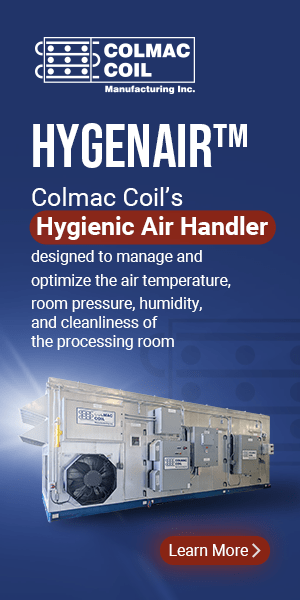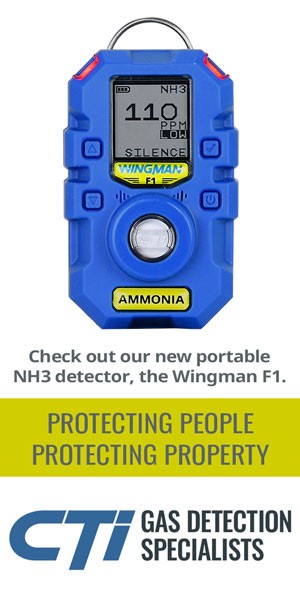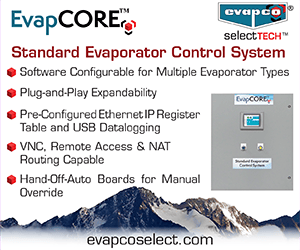Lowering Charge with Advanced DX Ammonia
This technomercial was authored by Colmac Coil Manufacturing Inc. to highlight the company’s offerings and provide an overview of Advanced Direct Expansion technology, with case studies.
Colmac Coil is one of the world’s leading manufacturers in the new and replacement coil markets with a mission to provide heat transfer and refrigeration markets worldwide with innovative products that are configured, manufactured and shipped with some of the shortest lead times in the industry
New technology that utilizes low charge direct expansion at low temperatures can improve safety and reduce the first cost of installation, while significantly reducing the ammonia charge required on site. That, in turn, can reduce the regulatory burdens associated with large ammonia inventories.“We’ve developed a special evaporator technology that allows us to get the same cooling effect from the evaporator with less ammonia,” said Bruce Nelson, president of Colmac Coil. “Our Advanced Direct Expansion (ADX) technology requires 30 to 50 times less ammonia in the evaporator compared to pumped ammonia. This removes a lot of ammonia from the occupied space.”
Reducing the amount of ammonia required in the refrigeration system is directly related to safety. Ammonia is the perfect refrigerant. It is highly efficient, low cost and environmentally friendly. Reducing the amount of ammonia on the site reduces risks associated with exposing people and products to ammonia in the event of a release.
The new ADX technology also provides faster defrosting, effective operation at multiple temperature levels, good response to changes in load, fast restart after power failure, and simplified maintenance and operation through elimination of recirculation pumps.
“Most of the reduction in the ammonia charge takes place in the evaporators. We have to have ammonia in the system, but using the Advanced Direct Expansion system can minimize the amount. The evaporators are installed in the cold space to absorb the heat and cool the air and are the part of the system closest to the products and people, so reducing the ammonia charge in the evaporators has a big benefit in terms of reducing risk.” Nelson said.
To make direct expansion with ammonia work at low temperatures, three fundamental problems had to be addressed.
“The first had to do with finding a way to overcome the separation of the liquid and vapor phases inside the evaporator tubes. At low temperatures all of the ammonia liquid runs along the bottom of the tubes, leaving the top of the tubes dry, and that results in a very large reduction in cooling capacity. Colmac solved this problem by adding a proprietary enhancement on the internal tubing surfaces which acts to distribute the liquid ammonia and wet all of the tubing surfaces evenly.”
“The second problem is the large negative effect on evaporator performance of even small amounts of water in the ammonia. The ADX design automatically and continuously removes water from the system and keeps evaporators operating at peak performance.”
“The third challenge had to do with distributing the ammonia equally to all of the parallel circuits in the evaporator. Conventional refrigerant distributors that operate on a pressure drop-turbulence principle just don’t work well with ammonia. Our Tank Distributor is designed to work with very low pressure drop over a very wide range of cooling capacities. It is insensitive to subcooling, and allows the same evaporator to work over a very wide range of temperatures and load conditions – for example in convertible rooms,” said Nelson.
Low-charge ADX ammonia technology brings with it a number of cost savings. It is less expensive to install than a traditional pumped ammonia system because of smaller line and vessel sizes, and elimination of the recirculator package, making return on investment extremely attractive with ADX.
Additionally, lowering the amount of ammonia stored on-site can reduce the number of regulatory inspections facilities face.
Meanwhile, several government agencies are taking a closer look at the regulation of refrigeration plants. Because of the National Emphasis Program, systems with an ammonia charge of 10,000 lbs or more may put that facility on a short list for visits and inspections by EPA, OSHA, and the Department of Homeland Security. Reducing the system ammonia charge is beneficial, no matter the size of an operation, but being able to design a large facility with less than 10,000 lbs is a significant reduction in regulatory burden. With a technology like low-charge ADX, that capability is coming into the mainstream.

















